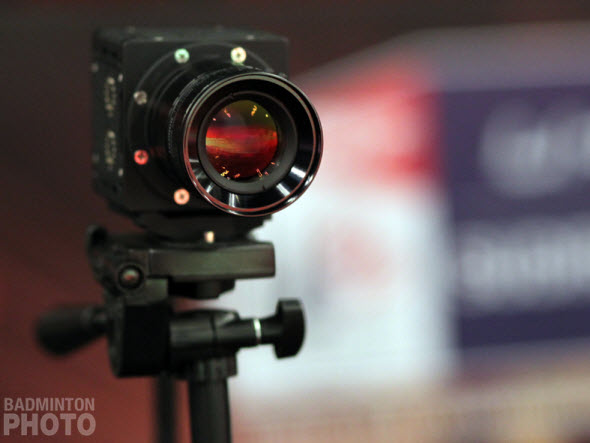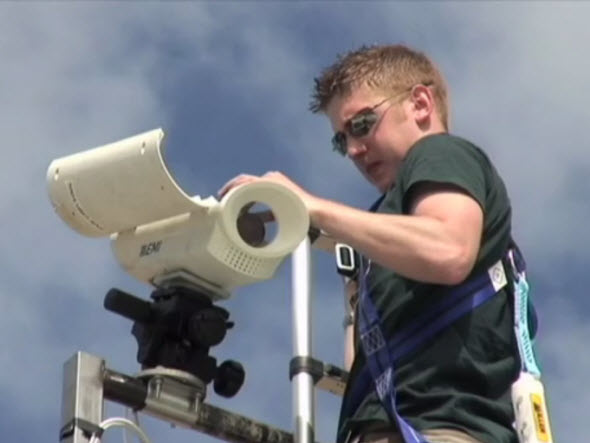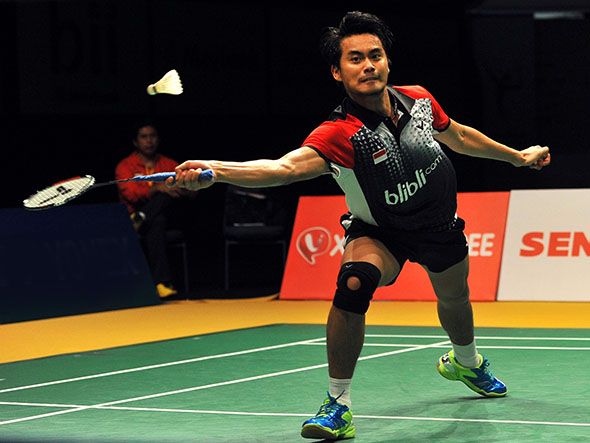A “badminton Hawkeye system” that is different to the tennis one

In the second men’s singles match at the Singapore leg of the BWF Super Series on April 11, 2014, India’s Srikanth K challenged the call of the line judge. Soon after, computer animation similar to that of the Hawkeye system used in tennis appeared on TV screens. This was the further use by the BWF of a technological assistance system since the Instant Review System (IRS) was formally introduced at the Super Series Finals in December, 2013 to make badminton competitions fairer.
On April 4 during the Indian Open, the BWF said in a press release that, after testing the systems of various suppliers for several months, it had decided to sign a contract with Hawkeye Innovation and the company would be responsible for the IRS system judging assistance tool at world class tournaments and Super Series tournaments organized by the BWF, and that it would be officially introduced after the India Open.
Hawkeye introduced in two stages
However, TV screens did not show Hawkeye’s computer animation during the India Open, however the speed at which player challenges were dealt with was much faster than before when IMG was in charge, with officials at courtside still holding up boards to notify the umpire of the result. A source at the venue of the India Open said that Hawkeye was introduced in two stages.
|
Like DBS Consulting and IMG before, eight high-speed cameras were directed at the back lines and side lines of both sides of the court, then they were linked by optic fiber to courtside computers. The Hawkeye cameras are 660 frame/second high speed cameras, with a two second delay time setting that allows officials to quickly confirm the shuttlecock landing spot. In the second stage, trackers on the roof were used and then simulation calculation carried out and a computer animation made like in tennis.
The company used the trackers to collect a large amount of information about shuttlecock flight paths at the India Open and officially introduced the computer simulation function in the last eight stage of the Singapore Open. However; the spectators at the venue did not see the animated simulation that was seen on TV screen and online. All they could see was officials holding up borads showing the judging decision with |
 IRS System IRS System(Photo source: http://youtu.be/AVo25iYUawE?t=7m7s) |
The risk of mistakes by Hawkeye
There was one NO DECISION from the system at the Singapore Open, with the situation explained to the umpire by the referee in person. What had happened was that, in the mid-match break, a cameraman had been filming a coach instruct a player and had accidentally caused one the high speed camera’s optic fiber to become detached which meant that there was no image on which a final decision could be made when the player made the challenge.This situation shows that the Hawkeye system used in badminton at present is based on the images of the Instant Review System.
In Hawkeyes computer simulated animation, the simulated flight path of every shuttlecock is diagonal, which is slightly different to the flight path of a real shuttlecock. For example, one of Lee Chong Wei’s challenges in the men’s singles final at the Singapore Open was a lob by his opponent that fell from the air almost vertically when it reached the back of the court, however the computer animation showed that is fell diagonally. Seeing this kind of computer simulated animation on the screen some people must have begun to doubt the suitability of using the Hawkeye tennis program for badminton.
The Hawkeye system used in tennis has eight high-speed cameras set up around the court and a computer carries out overall calculation to build a simulated 3D space and calculate the position of the tennis ball as it moves through this space.
The judging assistance system used at present in tennis is provided by Hawkeye Innovation (a Sony subsidiary), however a shuttlecock is only five grams in weight and its flight path is easily affected by air currents at the venue (air conditioning) and the condition of the feathers, which means that a shuttlecock’s flight path can’t be completely calculated by computer simulation.
Using Hawkeye as a badminton judging aid isn’t just a gimmick and the BWF should now urge the supplier to improve the current computer simulation program to make it more suitable to the sport of badminton.(The above content represents the personal views of the author and not this company)
( Edit by VICTOR Badminton )
|
Mackinglis |
| - Well-known badminton blogger - http://campus999.blogspot.tw/ |
| - Obsess in international badminton event since 2008 Beijing Olympics |
| - Specialize in analyzing world badminton players’ affair |
| - Worked in international news agency as editor and reporter |
| - Translate a lots of international badminton news and interviews |
| - Interviewed many top badminton player and coach in the word |
















